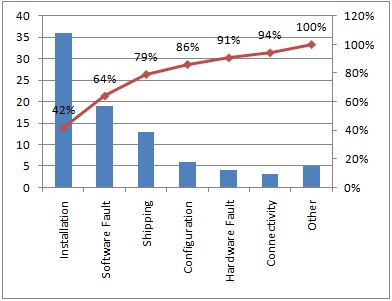Pareto analysis in construction
Pareto analysis is a statistical decision-making technique that identifies a limited number of input factors as having a greater impact on outcomes, whether they are positive or negative. It is based on the Pareto Principle, popularly known as the ‘80/20 rule’, that stipulates that 80% of the outputs result from 20% of the inputs.
The principle was developed by Vilfredo Pareto, a 19th century Italian economist and sociologist who was researching wealth distribution. He subsequently discovered the 80/20 rule applied to areas outside of economics, for example, 80% of the peas in his garden were produced by only 20% of the peapods planted.
Pareto analysis can also be used as a project management tool. For example, the majority of problems (80%) are produced by relatively few causes (20%); and 80% of the project’s benefits are delivered through 20% of the work.
Put simply, Pareto analysis shows that a disproportionate improvement can be made by ranking the various causes of a problem and allocating resources to tackling those that have the largest impact.
In construction, there may be a problem with the project programme that is the result of a large number of causes. Through observation and the collection of data, it might be determined that there are 8 causes. Pareto analysis may show that 80% of the problems result from the top 2 or 3 causes. The project management team can then plan an appropriate response, targeting resources at those 2 or 3 causes, rather than all 8.
A Pareto diagram (or chart) can be used to present the analysis, helping the project team to focus on the inputs with the greatest impact.
Inputs are listed along the horizontal ‘y’ axis in descending order of output frequency (using the cumulative percentage of the outputs), and uses a line graph to chart them. The vertical ‘x’ axis measures the frequency of the output for each input, and uses a bar graph to chart them.
In the example diagram, it can be seen that 42% of the issues are related to installation, and that three of the categories; installation, software faults, and shipping, account for 79% of the issues.
[edit] Related articles on Designing Buildings
- Acceleration.
- Benchmarking.
- Contingency theory.
- Critical path method.
- Gantt chart.
- Key performance indicators.
- Line of balance (LOB).
- Milestones.
- Plan, Do, Check, Act (PDCA).
- Project crashing.
- Project manager.
- Project quality plan PQP.
- Quality in construction projects.
- Quality Management System.
- Resource leveling.
- Time-location chart.
- Time management.
- Value management.
- Work breakdown structure
[edit]
Featured articles and news
RTPI leader to become new CIOB Chief Executive Officer
Dr Victoria Hills MRTPI, FICE to take over after Caroline Gumble’s departure.
Social and affordable housing, a long term plan for delivery
The “Delivering a Decade of Renewal for Social and Affordable Housing” strategy sets out future path.
A change to adoptive architecture
Effects of global weather warming on architectural detailing, material choice and human interaction.
The proposed publicly owned and backed subsidiary of Homes England, to facilitate new homes.
How big is the problem and what can we do to mitigate the effects?
Overheating guidance and tools for building designers
A number of cool guides to help with the heat.
The UK's Modern Industrial Strategy: A 10 year plan
Previous consultation criticism, current key elements and general support with some persisting reservations.
Building Safety Regulator reforms
New roles, new staff and a new fast track service pave the way for a single construction regulator.
Architectural Technologist CPDs and Communications
CIAT CPD… and how you can do it!
Cooling centres and cool spaces
Managing extreme heat in cities by directing the public to places for heat stress relief and water sources.
Winter gardens: A brief history and warm variations
Extending the season with glass in different forms and terms.
Restoring Great Yarmouth's Winter Gardens
Transforming one of the least sustainable constructions imaginable.
Construction Skills Mission Board launch sector drive
Newly formed government and industry collaboration set strategy for recruiting an additional 100,000 construction workers a year.
New Architects Code comes into effect in September 2025
ARB Architects Code of Conduct and Practice available with ongoing consultation regarding guidance.
Welsh Skills Body (Medr) launches ambitious plan
The new skills body brings together funding and regulation of tertiary education and research for the devolved nation.
Paul Gandy FCIOB announced as next CIOB President
Former Tilbury Douglas CEO takes helm.
UK Infrastructure: A 10 Year Strategy. In brief with reactions
With the National Infrastructure and Service Transformation Authority (NISTA).
























